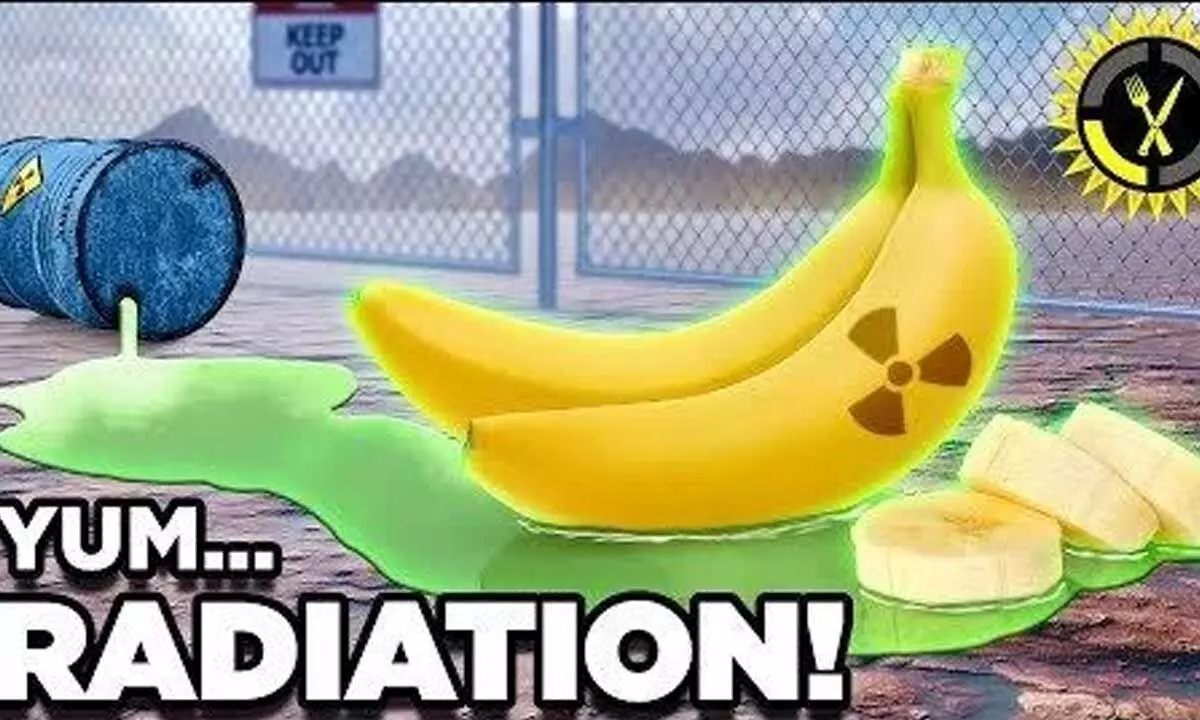Are bananas really 'radioactive'?

Are bananas really ‘radioactive’?
The simple mention of the word “radiation” often evokes fear in people
The simple mention of the word "radiation" often evokes fear in people. For others, it's fun to think a little exposure to radiation could turn you into the next superhero, just like the Hulk. But is it true basically everything around us is radioactive, even the food we eat? You may have heard bananas are mildly radioactive, but what does that actually mean? And despite us not being superheroes, are human bodies also radioactive?
What is radiation?
Radiation is energy that travels from one point to another, either as waves or particles. We are exposed to radiation from various natural and artificial sources every day. Cosmic radiation from the Sun and outer space, radiation from rocks and soil, as well as radioactivity in the air we breathe and in our food and water, are all sources of natural radiation.
Bananas are a common example of a natural radiation source. They contain high levels of potassium, and a small amount of this is radioactive. But there's no need to give up your banana smoothie – the amount of radiation is extremely small, and far less than the natural "background radiation" we are exposed to every day. Artificial sources of radiation include medical treatments and X-rays, mobile phones and power lines.
There is a common misconception that artificial sources of radiation are more dangerous than naturally occurring radiation. However, this just isn't true. There are no physical properties that make artificial radiation different or more damaging than natural radiation. The harmful effects are related to dose, and not where the exposure comes from.
Radioactivity
The words "radiation" and "radioactivity" are often used interchangeably. Although the two are related, they are not quite the same thing. Radioactivity refers to an unstable atom undergoing radioactive decay. Energy is released in the form of radiation as the atom tries to reach stability, or become non-radioactive. The radioactivity of a material describes the rate at which it decays, and the process(es) by which it decays. So radioactivity can be thought of as the process by which elements and materials try to become stable, and radiation as the energy released as a result of this process.
Ionising and non-ionising
Depending on the level of energy, radiation can be classified into two types. Ionising radiation has enough energy to remove an electron from an atom, which can change the chemical composition of a material. Examples of ionising radiation include X-rays and radon (a radioactive gas found in rocks and soil). Non-ionising radiation has less energy but can still excite molecules and atoms, which causes them to vibrate faster. Common sources of non-ionising radiation include mobile phones, power lines, and ultraviolet rays (UV) from the Sun.
Is all radiation dangerous?
Not really! Radiation is not always dangerous – it depends on the type, the strength, and how long you are exposed to it. As a general rule, the higher the energy level of the radiation, the more likely it is to cause harm. For example, we know that overexposure to ionising radiation – say, from naturally occurring radon gas – can damage human tissues and DNA. We also know that non-ionising radiation, such as the UV rays from the Sun, can be harmful if the person is exposed to sufficiently high intensity levels, causing adverse health effects such as burns, cancer, or blindness. Importantly, because these dangers are well known and understood, they can be protected against. International and national expert bodies provide guidelines to ensure the safety and radiation protection of people and the environment.
Radiation in medicine
Medical imaging uses ionising radiation techniques, such as X-rays and CT scans, as well as non-ionising radiation techniques, such as ultrasound and magnetic resonance imaging (MRI). These types of medical imaging techniques allow doctors to see what's happening inside the body and often lead to earlier and less invasive diagnoses. Medical imaging can also help to rule out serious illness.
Radiation can also help treat certain conditions – it can kill cancerous tissue, shrink a tumour or even be used to reduce pain.
So are our bodies also radioactive? The answer is yes, like everything around us, we are also a little bit radioactive. But this is not something we need to be worried about. Our bodies are built to handle small amounts of radiation – that's why there is no danger from the amounts we are exposed to in our normal daily lives. Just don't expect this radiation to turn you into a superhero any time soon, because that definitely is science fiction.
(Writer is a faculty at University of Wollongong, Australia; The Conversation)







